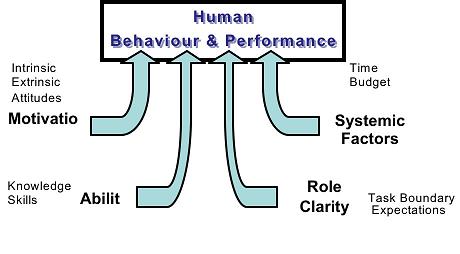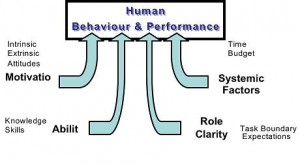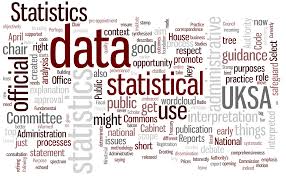MARS Model of Individual Behaviour and Results in an Organizational Context
MARS model is a predictive behavioural model that aims at analyzing how four major factors drive the human behaviour and the way that behaviour gets translated into results. In other words, a combination of these four factors decides or predicts human behaviour and performance. MARS stands for Motivation, Ability, Role Perceptions and Situational Factors. MARS model takes into account the fact that both internal as well as external factors play a decisive role in molding one’s behaviours and performance. Motivation, ability and role perceptions are factors that are under control of an individual and hence can be viewed as internal factors – motivation and ability are either innate, or acquired or learnt, and role perceptions denote the idea and image one has of one’s role and the way he perceives or understands it. On the contrary, situational factors are external environmental factors that impact or influence one’s behaviour and the results but are beyond the control of an individual.
In an organizational setup, any result refers to a performance given by an employee. Employee behaviours are the performance-enabling behaviours, i.e. those particular behaviours that lead an individual to demonstrate a stellar or an average or an inferior performance. As per MARS model, motivation, abilities, role perceptions and situational factors act together in synergy to result in a particular type of behaviour and performance. It is crucial to note that absence of any of these factors will not result in the expected performance despite the influence of other factors. Say, for example, an employee has enough motivation to perform his job nicely, a clear understanding of his role expectations and positive or empowering situational factors, but is deficient in abilities, i.e. competencies needed to perform the job efficiently. In such a situation, the employee won’t be able to deliver the expected level of performance. Similarly, an individual with adequate motivation, abilities and facilitating situational factors, will fail to be a super performer if he doesn’t have the correct role perceptions.
The first element ‘Motivation’ simply implies the eagerness and urge with which one pursues a given work. A motivated person willingly and eagerly puts in effort to accomplish a task at hand. Motivation determines the kind of behaviour one employee is likely to demonstrate in the workplace and his attitude towards his work. Motivation has 3 components – direction, intensity and persistence. A person is motivated towards the achievement of a particular goal or goal-set. It is in the direction of this goal or goal-set that a person will channelize all his efforts and enthusiasm – hence, motivation has a specific direction the sense of which grows when one is aware of his specific aims or goals. The second component, intensity refers to the extent of effort that one puts forth in order to achieve the desired goals. Persistence implies tenacity – the perseverance shown by a person in accomplishing a goal. Persistence denotes whether a person gives up when faced with hurdles or obstacles, or he sticks to his purpose and continues to put forth effort towards the purpose in a sustained manner.
The second element ‘Ability’ shifts the focus from behaviour to actual performance. Motivation alone cannot serve as a performance-enabler. An employee needs to have requisite knowledge and skills to execute a given task. Ability can denote an innate talent or an inherent aptitude that lets a person learn or acquire some specific knowledge or skill more quickly and more efficiently than others. Ability can also denote the proficiencies or expertise one has acquired on-the-job. The term ‘ability’ can be used interchangeably with the term ‘competency’ which refers to characteristics that translate to a stellar performance.
Role perception means the degree of clarity with which an employee understands what his role is and what exactly is expected from him when he is the role incumbent. Adequate motivation and ability will not be fruitful if the efforts and energy are spent on some tasks that not even required of a person whereas some required tasks lie unattended. Role clarity can be explained from 3 dimensions:
– How clearly and accurately an employee knows what exact duties are expected of him and on what parameters will his performance be assessed.
– How clear idea does an employee have regarding prioritizing the set of duties he is entrusted with, i.e. is he aware of the relative importance of the tasks at hand? If there is lack of awareness or clarity on this front, then an employee may end up spending more effort on a relatively less important task thereby putting the more important task at the backseat.
– Is the person employing ways, methods and procedures that are compliant with the organizational standards or norms or specifications while carrying out his work?
Whereas the above three factors are internal factors, the last factor, i.e. the Situational Factors is the only external determining factor of behaviour and performance. It encompasses all those external conditions and situations that can either facilitate or deter the superior execution of a work. These situations are beyond an employee’s control, and hence while performance evaluation, presence or influence of these factors should be duly considered but an employee should never be held accountable for outcomes caused by these factors. In an organization, situational factors can include allocated budget, time, availability of efficient resources, facilities present, cooperation from external sources etc.
MARS Model, therefore successfully analyzes the reasons behind the types of behaviours shown by individuals and the performances delivered by them, based on the four major predictive factors. This model also depicts how each of these factors act as crucial and indispensable factors in determining the behaviour and performance – lack of any one can cripple the performance notwithstanding the solid presence of other factors.





9 Comments. Leave new
Informative
Very cohesively written..good one
Informative article..!
A new concept to me… Informative article.. Good job..
Very informative!
Nicely plotted
nice
nice
Thank you guys for going through my article and liking it !